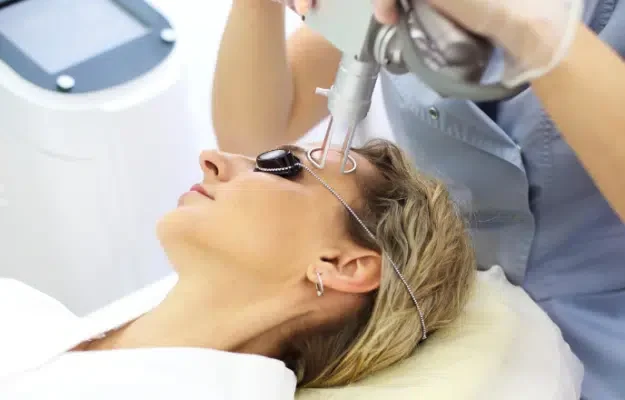A mole, also known as a benign pigmented naevus, involves the dermis and the epidermis. Complete surgical removal therefore often results in a minor skin defect. Any type of surgical procedure, including mole removal, will result in a scar. Mole removal at Centre for Surgery is carried out using techniques designed to minimise the appearance of scars.
In some cases, particularly if the mould is very small, the surgeon may elect to leave the minor skin defect to heal on its own without stitches. However, in most cases, an elliptical incision is made around the mole to facilitate skin closure along the natural lines of skin tension to minimise the appearance of the scar. Facial mole removal will often require stitches to be removed earlier to avoid prominent scars. Moles found elsewhere on the body may involve using deeper stitches and overlying skin tape to avoid unsightly stitch holes.
Moles that are raised above the level of the skin can often be removed with shave excision or with erbium laser. Laser mole removal with Erbium YAG laser is a particularly effective technique for cosmetic mole removal. It is essential to remember that although the mole has been lasered to remove localised pigment, some residual mould tissue may remain. This may slightly increase the chances of mole recurrence. Although rare, it may result in visible scarring, which may need to be addressed with surgical scar revision. Some moles may have a hairy component, and these types of moles should be removed surgically to prevent hair regrowth from the deeply situated hair follicles. Moles that exhibit cancerous features should be surgically removed and sent for diagnostic histology to confirm their nature, whether benign or malignant.
RELATED: Should I be concerned about an itchy or bleeding mole?
After mole removal, proper wound care will help to minimise the risk of infection and potential worsening of the scar. Antibiotics are only given to treat active infection and should not be used in a prophylactic manner as this may increase the risk of antibiotic resistance developing.
Moles in certain body parts may result in more prominent scarring than in other areas. Some people are more likely to develop noticeable scars, particularly those with darker skin types or a history of keloid scars. If you think you may be at risk of developing keloid scars, please let your doctor know so that the most appropriate treatment can be undertaken.
What is the best way to minimise scars after mole removal?
Mole scars can be improved by ensuring your treatment is carried out by an appropriately experienced plastic surgeon with expertise across the full range of mole removal techniques, including shave excision, surgical excision and laser mole removal.
RELATED: Why choose a plastic surgeon for mole removal?
After mole removal, several recognised techniques can be used to improve mole scars. Once the incision has fully healed, the application of silicone gel sheets can help to flatten scars quickly. Certain types of laser treatment can be used to improve red scars or raised hypertrophic scars. Morpheus8 is particularly effective for surgical scars, including mole scars. Non-invasive treatments include topical products, which may contain vitamin E to help keep the scar moist and reduce redness. We are fortunate to offer the full range of scar treatments at our Baker Street clinic in Marylebone.
After mole removal, it is important to maintain the cleanliness of the wounds and keep them appropriately covered for the first few days after treatment. Petroleum jelly will help to keep the incision sites moist to prevent scab formation. The development of scabs may increase the risk of subsequent scarring. The mole removal dressings should be changed regularly to maintain moistness, and the healing incisions should be kept out of direct sunlight.
You should avoid applying alcohol onto mould removal scars as this can adversely affect healing, which may increase the risk of infection. Once the incisions have fully healed, localised massage will help to break down localised scar tissue and promote vascularity of the area. Healing can be quickened with regular mole scar massage and promote suppleness of the area.
When do mole scars begin to fade?
A mole scar can take over 12 months to lighten and form a pale white scar. Certain cosmetic interventions can help speed up the process. Laser treatment and Morpheus8 can help to improve the appearance of the mole scar in as little as three months with permanent and significant results.
Here at the Centre for Surgery in London, our surgeons are experts in mole removal, using the most advanced techniques to ensure a quick recovery after treatment. If you would like to learn more about minimising scarring after mole removal, please contact us on 0207 993 4849 or complete the contact form below to book a consultation.
Can a mole grow back after surgical removal?
After surgical removal, it is very rare for moles to grow back, provided the mole is entirely removed, and diagnostic histology has confirmed complete removal. If you notice a mole to recur, please get in touch with your plastic surgeon to arrange a follow-up appointment. In some cases of hairy moles, hair follicles may grow back in the area. This can be easily treated with a variety of non-surgical or surgical methods.
Why choose Centre for Surgery for mole removal or mole scar removal?
Centre for Surgery is a leading cosmetic surgery clinic with expertise in mole removal and treatments to improve the appearance of mole scars. Our expert plastic surgeons are experienced in mole checks and treatment of all types of moles. They are trained in the most effective surgical techniques that ensure complete removal of the mole and cosmetically acceptable mole scars. Get in touch with us today and receive expert treatment from the leading mole removal clinic in London.










